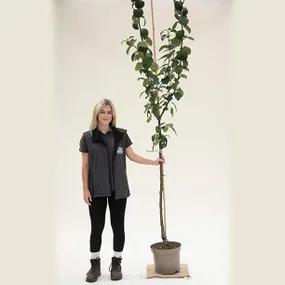Bountiful Apple Trees
Honest Delivery Prices- Cooking: Sweet. Keeps shape after cooking. Also eaten fresh
- Spur bearer (Good for cordons & espaliers
- Not self fertile
- Pollinator
- Pollination Group A/B
- Crops in Late September. Stores till November.
Recommended extras
Description
Bountiful Apple Trees
Bountiful apple trees produce mid season cooking apples that are also good to eat fresh.
Browse our full range of apple trees or see the full variety of fruit trees.
Characteristics of Bountiful Trees:
- Use: Cooking. Sweet. Holds shape when baked. Eaten fresh, it is quite sharp and juicy.
- Spur Bearer: suitable for cordons & espaliers, trained on wires.
- Tree's growth habit: Average vigour. Compact form.
- Harvest: Late September.
- Store & ripen in a cool, dry place: Until November.
General description of Bountiful:
These large apples are mainly used for cooking, which makes them sweet and firm with a moist texture that oozes with juice. Because they hold their shape after being sliced and cooked, they are good for topping apple pies and other apple desserts that need to look neat as well as taste good.
They are well shaped apples, predominantly green and take on a red blush towards the end of the season. The fresh fruit are generally best used for cooking, but as they ripen off the branch by mid October you can use them a nice, crisp eating apple, if you like a sharp flavour.
These trees are naturally quite tidy and low maintenance in terms of pruning. They begin cropping heavily when they are young.
Rootstocks:
All of our Bountiful trees are grown on MM106 rootstocks, except for the cordons, which are grown on M9 rootstocks.
Pollination Partners for Bountiful:
Your trees are self sterile and their flowers must be pollinated to make fruit.
Bountiful flowers for a long time, so it is really in pollination Groups A & B.
This means that they will cross-pollinate with other apple trees in pollination Groups A, B & C.
See our Guide to Apple Tree Pollination for a full list of partners & more tips about pollination.
Bountiful Disease notes:
Disease resistance: Mildew.
History & Parentage:
This is a relatively new variety of apple tree, bred in the 1960's at the East Malling Research Station in Kent, reputedly from a Cox's Orange Pippin, which is a supremely tasty apple, and a Lane's Prince Albert which, like Bountiful, stays in one piece when used as a cooking apple.
How Apple Trees are Measured & Delivered:
Our fruit trees are delivered in up to 3 shapes and you can also buy selected apple trees as ready made cordons.
Maiden: This unbranched tree is the smallest starting size. You can train maidens into espaliers and cordons.
Cordon: Bountiful trees are spur-bearers, so they can be made into cordons and espaliers.
Bush: This is a style of freestanding tree with a short trunk of about 60cm. It will grow to about 3 metres tall.
Half-Standard: This is a freestanding style that will grow into a full sized, "normal" apple tree, about 4 metres tall.
Planting Instructions
Notes on planting Bountiful trees:
All fruit trees like a rich soil with decent drainage, protection from the wind and plenty of sun. Apple trees like clay soil, as long as it is not prone to bad waterlogging.
This tree is suitable for organic growing in the drier East of Britain, where mildew is more common.
Prepare your site before planting:
Improving the soil in advance of planting your apple trees will help them establish quickly and be productive for years to come. After you have destroyed all the weeds and grass, you can dig the soil over. Remove any stones and rubbish and mix in well rotted compost or manure down to the depth of about 2 spades.
You can do this on planting day, but when you do it weeks or months in advance, you will give the soil time to settle again.
Spacing Bountiful apple trees:
Freestanding bushes: 12-18 feet (4-6 metres) between trees and rows.
Freestanding half-standards: 18-30 feet (6-10 metres) between trees and rows.
In general, allow 1 more metre between rows than there is between each tree in the row.
Wire-trained cordons can be planted in rows 60-100cms apart.
Espaliers need to be spaced at 10-18 feet (3-6 metres) apart.
Watch our video on how to plant a fruit tree for full instructions on planting a bush or half-standard sized tree.
If you are growing a maiden sized apple tree into a freestanding tree, a bamboo cane is enough support.
If you are growing a cordon or espalier, you will need to install training wires to support them.
Remember to water establishing apple trees during dry weather for at least a year after planting.
Apple Tree Planting Accessories:
For bush and half standard apple trees, our tree planting pack includes a wooden stake & rubber tie to support the tree and a biodegradable mulch mat with pegs, which protects the soil at the base of your tree from drying out and stops weeds from sprouting.
We recommend using mycorrhizal "friendly fungi" on the roots of all new trees, especially if your soil is poorly fertile.

 Img 1.webp)
 Img 1.webp)


 Img 2.webp)
 Img 3.webp)
